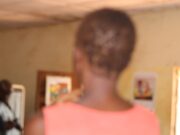*On a cloudy Thursday morning, a mother stands beside her 11 year old son as he lies on the cold floor of a health center in Namoruputh location, Loima district in Turkana County. The boy is too weak, unable to sit up or stand on his own.
Epyot Etaba and his mother have been at the health center for the last four weeks where he has been receiving treatment for his failing health. Getting to the health center was not an easy journey for mother and son as the transport and communication network in Namoruputh is poor. The roads are inexistent and most residents have to walk long distances to seek basic services, including healthcare.
Weak and unable to walk on his own, Epyot’s mother had carried him on her back, trekking over the dry and rough terrain in the hot weather. It is a journey that took them five agonizing days.
A health worker at Namoruputh Health Center explains the state in which Epyot arrived at the facility.
“He was completely dehydrated, emaciated and with severe malnutrition. His lips were parched, he was dirty and barely conscious. He and his mother had not eaten for days.”
The health worker also noted that Epyot’s abdomen was swollen and his skin filled with burn wounds, which appeared to be septic. Even before embarking on any medical tests, she already appeared to know what Epyot was ailing from.
“I knew that he was suffering from a rare disease called Visceral Leishmaniasis, which is also known as Kala Azar,” she says.
Kala Azar is listed by the World Health Organization as one of the 17 neglected tropical diseases (NTDs). These are a diverse group of diseases with distinct characteristics that are common among the poorest people.
Kala Azar is transmitted through the bites of infected female sandflies. Sand flies are common in areas where the land is dry and hot, there is livestock and there are termite mounds.
Having never been to school, Epyot and his family are pastoralists. They spend their days grazing their cows, goats and camels moving from place to place in search of pasture and water. The areas they roam are dry, hot and filled with hundreds of termite mounds –the perfect habitat for sand flies.
Symptoms of the disease include high fever, weight loss, fatigue, general weakness and anaemia. As the infection spreads, it affects some organs such as the skin, liver, spleen and bone marrow. Most Kala Azar patients develop an enlarged abdomen –caused by the swollen liver and spleen. If left untreated, Kala Azar could be fatal. But even when faced with glaring health conditions which would need immediate medical attention, various obstacles make it difficult for populations affected by this disease to do so. This is because they live in areas of high poverty that are underdeveloped with little or no infrastructure.
“Health centers are few and far apart, which forces residents to walk for tens of kilometres to reach the nearest health facility, says the health worker.
Economic factors, strong cultural practices and low education levels also add on to the health challenges among these communities. Because of these factors, pastoralist communities device their own treatment methods for various health ailments.
A clinical officer at Namoruputh Health Center describes how some of the community members try to treat Kala Azar.
“They take camel dung lumps and burn them in the fire until they become red hot briquettes. They then take the hot coals and press them onto the enlarged abdomen of the sick person, in the belief that the germs in the stomach will be destroyed. They also cut the skin around the abdomen it with a sharp razor blade and as the blood gushes out, they believe the germs causing the stomach to swell exit together with the blood,” he says.
But the swelling never goes down. In fact, the hot burns cause raw wounds and in most cases, become septic. Children are not spared from these forms of painful traditional ‘treatment’.
A child’s health can deteriorate more quickly than that of an adult. If immediate medical treatment is not sought, the child can lose his life in no time. Unfortunately, because of health centers being far away, unavailability of transport and ignorance, many children suffering from Kala Azar die in their homes.
Thankfully though for Epyot, he had managed to reach the health center just in time. But this was after failed attempts by his family to offer him the traditional ‘treatment’. Epyot had had his abdomen burnt with hot camel dung briquettes in the hope of healing him. But the treatment had not worked and in a last bid to save his life, his mother had carried the frail boy on her back to the Namoruputh Health Center, in a journey that took them five days.
“Because he arrived here dehydrated and emaciated, we had to first put him on a meal of specialized nutritious porridge to try boost his immunity. The porridge is made of 65 per cent corn, 25 per cent soya and 10 per cent sugar and which is then mixed with powdered milk. We also put him on daily iron and folic acid supplements because he was anaemic,” says the health worker, who adds that Epyot also began immediate treatment for the glaring septic wounds on his abdomen.
Despite his weakness, Epyot is on his way to recovery, having been on Kala Azar treatment for the last two weeks, and which will go on for another two weeks. He is on a drug called sodium stibogluconate (SSB), which is a 30 day course administered intravenously.
“It is a regimen that must be strictly adhered to. We discourage patients from returning home before the treatment is over because they will default, and this could lead to their death. Besides, most of them live far away so it only makes sense for them to remain here until they complete the treatment course,” says the health worker.
Namoruputh Health Center does not have an in-patient capacity, but because of the treatment requirements for Kala Azar, patients make do with sleeping on the floors in the consultation rooms or on the veranda of the hospital.
Kala Azar is an expensive condition to treat, and it requires about 120,000 shillings for one patient. Aside from a basic consultation fee, Kala Azar patients at the Namoruputh Health Center do not have to pay any other treatment costs, offering families great relief.
So as Epyot recovers from an infection that threatens his livelihood, it only points out to various issues faced by pastoralist communities especially where health care is concerned. However, there is hope because with the devolved system of government which also includes devolvement of health services, it is expected that county governments will be able to address some of these challenges and offer better options for their residents.
*I originally published this article in The Star newspaper in 2014.
Are you implementing a community project targeting mothers that you’d like me to write about? Email me on maryanne@mummytales.com and I’ll get back to you.




































